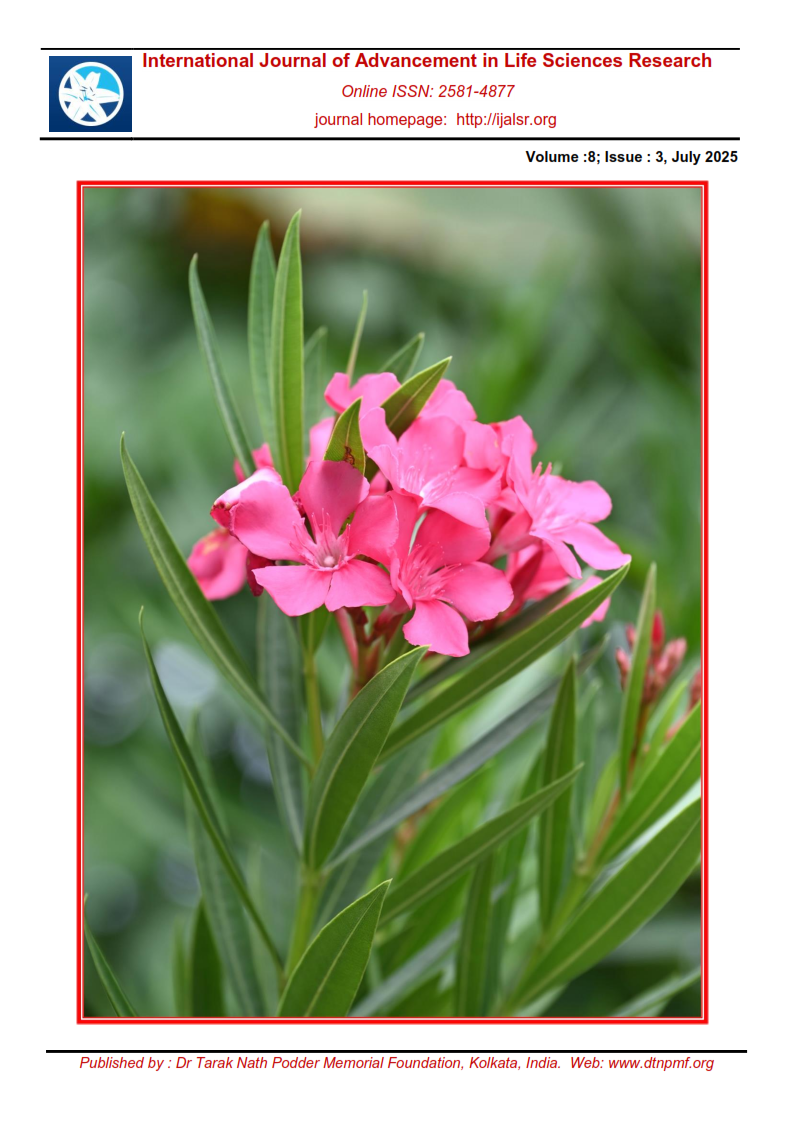Development and Validation of HPTLC Method for Estimation of Kaempferol and Luteolin in Arjunarishta Formulations Prepared by Traditional and Non-Traditional Mode
Abstract
Arjunarishta is an arishta preparation that evolved through the utilisation of specific ingredients via fermentation. It safeguards and fortifies the circulatory system and optimises heart muscle function by influencing cholesterol levels and blood pressure. The analysis of kaempferol and luteolin in Arjunarishta formulations prepared by the traditional mode (AT), non-traditional modes (AI and AS), as well as in the commercial Arjunarishta version (AM), has been made reliable through the development of a simpler, error-free, and precise HPTLC approach. The isolated yeast species obtained from Madhuca indica flowers and the standard strain of Saccharomyces cerevisiae SC1011 were adopted to accelerate the fermentation rate in the non-traditional Arjunarishta formulations, AI and AS, respectively. The developed HPTLC approach has been evaluated with respect to linearity, robustness, ruggedness, quantification and detection limits, and accuracy. It was found that the levels of luteolin in AI, AS, AT, and AM were 0.285%, 0.267%, 0.135%, and 0.106% w/w, respectively, and the levels of kaempferol were 0.355%, 0.361%, 0.342%, and 0.224% w/w, respectively. This documented work is the first report on the HPTLC determination of luteolin and kaempferol in Arjunarishta. Numerous investigations have demonstrated the antioxidative and protective effects of these compounds on cardiovascular health. The rigorous qualitative and quantitative analysis of kaempferol and luteolin via HPTLC not only validates the presence and concentration of these compounds but also ensures the therapeutic efficacy and safety of Arjunarishta. This scientific validation is crucial for establishing Arjunarishta as a reliable formulation for managing disorders of the circulatory system.
Downloads
References
Anonymous. (2008). The Ayurvedic Pharmacopoeia of India, Part II (Formulations), Volume II (p. 47). Government of India, Ministry of Health and Family Welfare, Department of Ayurveda, Yoga & Naturopathy, Unani, Siddha and Homoeopathy. Available at: https://naturalingredient.org/wp/wp-content/uploads/API-II-Vol-2.pdf
Borman, P., & Elder, D. (2017). Q2 (R1) validation of analytical procedures: text and methodology. ICH quality guidelines: an implementation guide, 127-166. https://doi.org/10.1002/9781118971147.ch5
Das, C., Ghosh, G., Bose, A., & Das, D. (2019). Analytical methods for standardization of Ayurvedic Asavas and Aristas; A review. Indian Journal of Pharmaceutical Sciences, 81(3), 396-405. https://doi.org/10.36468/pharmaceutical-sciences.523
Hidayatullah, M., Yuwono, M. & Primaharinastiti, R. (2022). Optimization Method and Stability Test forDetermination of Luteolin, Quercetin, Apigenin, Sinensetin Levels in Herbal Medicines Using TLC-Densitometry. Jurnal Farmasi dan Ilmu Kefarmasian Indonesia, 9(3), 235-241. https://doi.org/10.20473/jfiki.v9i32022.235-241
Hlatshwayo, S., Thembane, N., Krishna, S. B. N., Gqaleni, N., & Ngcobo, M. (2025). Extraction and processing of bioactive phytoconstituents from widely used South African medicinal plants for the preparation of effective traditional herbal medicine products: a narrative review. Plants, 14(2), 206. https://doi.org/10.3390/plants14020206
Majumder, S. & Saha, P. (2025). Quantitative estimation of quercetin from Phoenix sylvestris using validated HPTLC method. International Journal of Pharmaceutical Sciences and Research, 16(1), 162-66. https://doi.org/10.13040/IJPSR.0975-8232.16(1).162-66.
Mali, P. Y., & Goyal, S. (2020). HPTLC densitometric quantification of kaempferol from leaves of Euphorbia neriifolia. Indian Journal of Pharmaceutical Education and Research, 54, s586-s592. https://doi.org/10.5530/ijper.54.3s.158
Patil, S., Khushwah, P., Gudasi, S., Patil, M., Kunchanur, M., & Koli, R. (2024). Simultaneous Determination of Gallic Acid, Berberine and Trigonelline in Polyherbal Churna by HPTLC Method. Journal of Young Pharmacists, 16(2), 261-268. https://doi.org/10.5530/jyp.2024.16.34
Queiroz, M., Leandro, A., Azul, L., Figueirinha, A., Seiça, R., & Sena, C. M. (2021). Luteolin improves perivascular adipose tissue profile and vascular dysfunction in Goto-Kakizaki rats. International Journal of Molecular Sciences, 22(24), 13671. https://doi.org/10.3390/ijms222413671
Sahare, A. Y. & Khatri R. (2024). Review of arjuna Rishta: bridging ancient ayurvedic tradition with contemporary scientific validation. International Journal of Creative Research Thoughts, 12(11), c586- c591. Available at: https://www.ijcrt.org/papers/IJCRT2411289.pdf
Singh, A., Tiwari, R. C., Dikshit, M., Sharma, V. B., Mittal B. & Kumar N. (2025). Herbal science: exploring the phytochemistry and pharmacognosy of medicinal plants. International Ayurvedic Medical Journal, Online, 72-78. https://doi.org/10.46607/iamj1113012025
Taco, V., Palmieri, C., Borja, D., Villacrés, E., Duez, P., & Nachtergael, A. (2024). Qualitative Analysis by High-Performance Thin-Layer Chromatography–Bioautography of Ecuadorian Chenopodium quinoa Willd. Leaves: Influence of Variety, Phenological Stage, and Place of Cultivation on Free Radical Scavenging and α-Amylase Activity. Nutraceuticals, 5(1), 1. https://doi.org/10.3390/nutraceuticals5010001
Tambe, G. A., Singh, R., Yadav, P., & Prajapati, P. K. (2023). The status of fermented preparations in clinical practice: A charaka samhita review. Journal of Indian System of Medicine, 11(3), 176-183. https://doi.org/10.4103/JISM.JISM_2_23
Thakur, K. S., Patil, P., & Gawhankar, M. (2020). Standardization of Ayurvedic Formulation “Arjunarishta” In Terms of Physicochemical, Spectroscopy and Chromatographic Techniques.International Journal of Pharmaceutical Sciences and Research 11(12), 6237-6242. http://dx.doi.org/10.13040/IJPSR.0975-8232.11(12).6237-42
Verma, S. K., Pandey, M., Sharma, A., & Singh, D. (2024). Exploring Ayurveda: principles and their application in modern medicine. Bulletin of the National Research Centre, 48, 77. https://doi.org/10.1186/s42269-024-01231-0
Verma, V. & Jogdand, S. (2021). Medicinal Properties of Terminalia arjuna: A Review. Journal of Pharmaceutical Research International, 33(62A), 593-604. http://dx.doi.org/10.9734/jpri/2021/v33i62A35893
Vyas, A., Jain, V., Sahu, U., Kumar, N., & Joshi, N. (2023). HPTLC method development of herbal drugs and its validation: An overview. Research Journal of Pharmacy and Technology, 16(8), 3964-3976. https://doi.org/10.52711/0974-360X.2023.00652

This work is licensed under a Creative Commons Attribution-NonCommercial 4.0 International License.


















 .
.